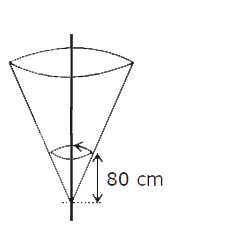A particle describes circular motion with its angular displacement θ at anytime t is given by θ=5t−3 radian. If the radius of circular path is 2m, find the total acceleration of particle.
θ=5t−3
ω=dθdt=5
α=dωdt=0
ac=ω2R=(5)2×2=50m/s2
a1=Rα=0
Total acceleration a=ac=50m/s2
Topper's Solved these Questions
Similar Questions
A particle moving along the circular path with a speed v and its speed increases by g in one second.If the radius of the circular path be r ,then the net acceleration of the particle is?
View SolutionA particle describing circular motion as shown in figure. The velocity of particle in m s is-
 View Solution
View Solution
Knowledge Check
- Question 1 - Select One
A particle moving along the circular path with a speed v and its speed increases by g in one second. If the radius of the circular path be r, then the net acceleration of the particle is:
Av2r+gBv2r2+g2C[v4r2+g2]1/2D[v2r+g]1/2 - Question 2 - Select One
A particle performing circular motion with its diameter d and velocity v. Then the angular displacement of the particle in time t is
AvtdB2vtdCvt2dDdvt - Question 3 - Select One
Angular displacement (θ) of a flywheel varies with time as θ=2t+3t2 radian. The angular acceleration at t=2s is given by
A14rad/s2B18rad/s2C6rad/s2D16rad/s2
The angular displacement of a particle is given by θ=t3+t2+t+1 then, its angular velocity at t=2 sec is …… rads−1
View SolutionIf the displacement of a particle is x=t3−4t2−5t, then the acceleration of particle at t=2 is
View SolutionA particle is moving on a circular path of radius 0.3 m and rotaing at 1200 rpm. The centripetal acceleration of the particle
View SolutionA particle starts rotating from rest. Its angular displacement is expressed by the following equation θ=0.025t2−0.1t where θ is in radian and t is in seconds. The angular acceleration of the particle is
View SolutionThe angular displacement of a particle is given by θ=t3+2t+1, where t is time in seconds. Its angular acceleration at t=2s is
View Solution

